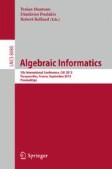Search
Search Results
-
A novel threshold changeable secret sharing scheme
A ( t, n ) threshold secret sharing scheme is a fundamental tool in many security applications such as cloud computing and multiparty computing. In...
-
On those Boolean functions that are coset leaders of first order Reed-Muller codes
In this paper, we study the class of those Boolean functions that are coset leaders of first order Reed-Muller codes. We study their properties and...
-
A New Encoding Algorithm for a Multidimensional Version of the Montgomery Ladder
We propose a new encoding algorithm for the simultaneous differential multidimensional scalar point multiplication algorithm d-MUL. Previous...
-
Enhancing an Attack to DSA Schemes
In this paper, we improve the theoretical background of the attacks on the DSA schemes of a previous paper, and we present some new more practical...
-
Expander-Based Cryptography Meets Natural Proofs
We introduce new forms of attack on expander-based cryptography , and in particular on Goldreich’s pseudorandom generator and one-way function. Our...
-
On Time-Space Tradeoffs for Bounded-Length Collisions in Merkle-Damgård Hashing
We study the power of preprocessing adversaries in finding bounded-length collisions in the widely used Merkle-Damgård (MD) hashing in the random...
-
On the Relationship Between Statistical Zero-Knowledge and Statistical Randomized Encodings
Statistical Zero-knowledge proofs (Goldwasser et al . in SICOMP: SIAM J Comput,
1989 ) allow a computationally unbounded server to convince a... -
Scientometric dimensions of cryptographic research
Information security has been a crucial issue in modern information management; thus cryptographic techniques have become inevitable to safeguard...

-
Cryptographic Hardness of Random Local Functions
Constant parallel-time cryptography allows to perform complex cryptographic tasks at an ultimate level of parallelism, namely by local functions that...
-
A Linear Algebra Attack to Group-Ring-Based Key Exchange Protocols
In this paper we analyze the Habeeb-Kahrobaei-Koupparis-Shpilrain (HKKS) key exchange protocol which uses semidirect products of groups as a...
-
Lattice Attacks on DSA Schemes Based on Lagrange’s Algorithm
Using Lagrange’s algorithm for the computation of a basis of a 2-dimensional lattice formed by two successive minima, we present some attacks on DSA...
-
Cheating detectable threshold scheme against most powerful cheaters for long secrets
In this paper, we propose a framework of cheating-detectable threshold schemes against the most powerful cheaters. Our scheme is used to distribute...
-
On (k, n)*-visual cryptography scheme
Let P = {1, 2, . . . , n } be a set of elements called participants. In this paper we construct a visual cryptography scheme (VCS) for the strong...
-
Constructing differentially 4-uniform permutations over GF(22m ) from quadratic APN permutations over GF(22m+1)
In this paper, by means of the idea proposed by Carlet (ACISP 1-15,
2011 ), differentially 4-uniform permutations with the best known nonlinearity... -
Towards the classification of self-dual bent functions in eight variables
In this paper, we classify quadratic and cubic self-dual bent functions in eight variables with the help of computers. There are exactly four and 45...
-
The relation and transformation between hierarchical inner product encryption and spatial encryption
Hierarchical inner product encryption (HIPE) and spatial encryption (SE) are two important classes of functional encryption that have numerous...
-
Construction of rotation symmetric Boolean functions with optimal algebraic immunity and high nonlinearity
Recent research shows that the class of rotation symmetric Boolean functions is potentially rich in functions of cryptographic significance. In this...
-
A counterexample concerning the 3-error linear complexity of 2 n -periodic binary sequences
In this article, we present a counterexample to Theorem 4.2 and Theorem 5.2 by Kavuluru (Des Codes Cryptogr 53:75–97,
2009 ). We conclude that the...
